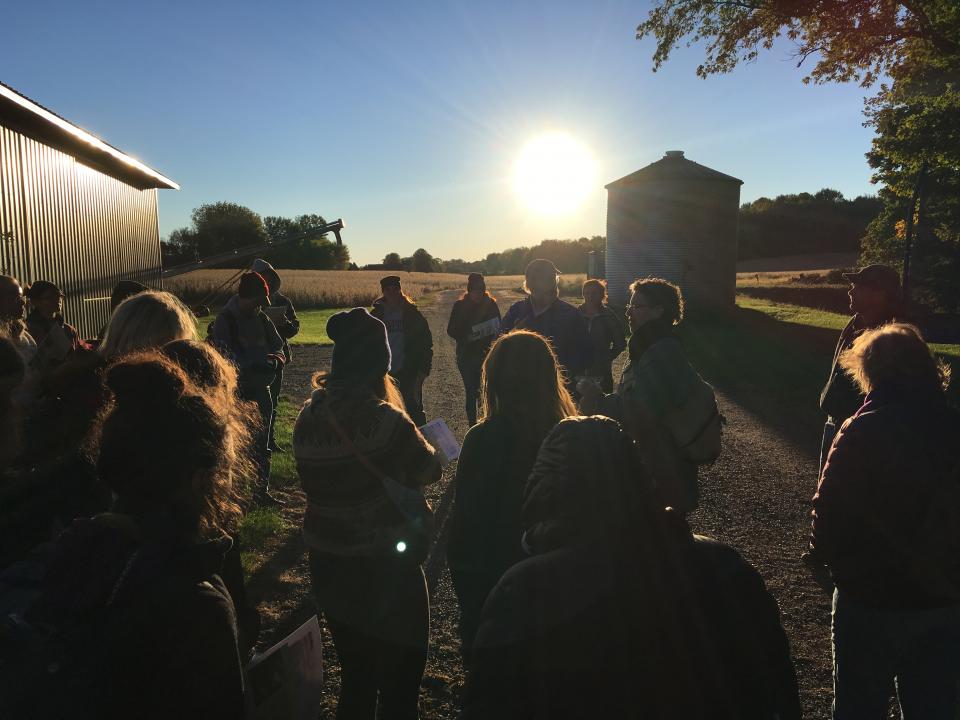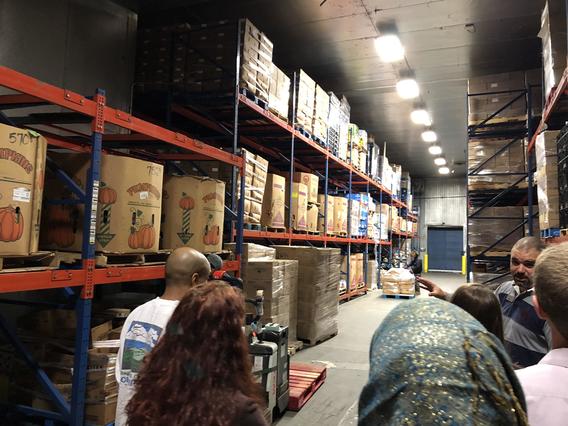November is a month for gathering in, taking stock of the year thus far, cultivating gratitude, and perhaps sharing a warm meal or two with family and friends. Yet in many places in Minnesota, where 1 in 11 households are affected by hunger, November can also mark the start of a difficult time of year, as communities grapple with how to provide needed resources and support to these individuals and families. Food insecurity—defined by the U.S. Department of Agriculture as the household-level economic and social condition of limited or uncertain access to adequate food—is a reality in both rural and urban communities. This year’s dual RCP partnerships with Scott and Ramsey Counties presents opportunities for University of Minnesota students to dig into projects that ask important questions spanning the entire food system from farm to table.
At the farm level, graduate and undergraduate students studying Environmental Science, Policy, and Management have spent the fall term working with staff and community stakeholders in Scott County to assess the viability of using perennial crops as an alternative to traditional row crop farming. Converting some agricultural land to perennial crops can help to reduce the use of fertilizer, water, fossil fuels, and other agricultural inputs, allowing for sustained crop yields without degradation of farmland. Students in ESPM 5245: Sustainable Land Use and Planning, taught by Dr. Mae Davenport, have connected directly with farmers and officials in the public sector to get a pulse on their appetite and capacity for transitioning to perennial crops. Ultimately, students’ work will help inform County staff and officials about what a successful policy to support perennial crops might look like, and more generally, what role the County can play in supporting farmers who want to pursue alternative approaches to growing food.
About 40 miles northeast of Scott County, RCP is partnering with Ramsey County to investigate the growing problem of food waste. Ramsey County recently adopted the EPA’s Food Recovery Hierarchy, effectively redefining the County’s role in reducing or eliminating the quantities of edible food that enter the waste stream. Through a match with the University’s Economic Development Fellows (EDF) Consulting Program in the U of MN's Office of the Vice-President for Research, a team of six graduate students from a range of academic disciplines are taking a multifaceted approach to finding actionable solutions to help the County meet its goals.
This semester, the EDF project team is collecting feedback from institutions such as hospitals, grocery stores, and school districts in Ramsey County to get a better sense of how food enters and flows through their organizations, the volume of food that is wasted, and unique challenges and barriers that contribute to spoiled or wasted food. Abbey Hammell, a third-year psychology Ph.D. student on the project team, was surprised to learn the volume of food that is discarded along the entire food chain. “It’s actually interesting how much food waste—about a third of the total amount—occurs in the homes of the consumers,” Hammell noted. “Before this project, I didn’t think about food waste nearly as often. Now I’m thinking more about my decisions as a consumer.”
organization serving the Twin Cities metro area.
Along with gathering feedback, students on the project team are scouring case-studies from communities in Minnesota and across the country to identify innovative and efficient strategies to redistribute edible food to food shelves, and reduce waste through composting or using a food-to-hogs model. Ultimately, Hammell said, the goal is to provide Ramsey County with valuable information it doesn’t already have, and identify points in the system where positive changes could be made with relatively little time or political inputs.
Matt Lupini, a second-year Master of Urban and Regional Planning (MURP) student at the Humphrey School of Public Affairs and the EDF team’s coordinator, remarked on the unique position of the County in addressing a problem like food waste. “My main takeaway has been seeing how involved municipalities actually are in issues I had always thought of as nonprofit issues,” Lupini said. “I’ve seen how involved Ramsey County wants to be in this work, how progressive they are in the policies they want to implement and in learning from other [communities] who have done the work before.”
Working with the Resilient Communities Project, the students say, has been an invaluable experience. Hammell noted that the EDF team is motivated and excited to work on the project, and the feeling seems to be mutual at the County. “The fact that they’re excited makes me feel like my work is important. It feels like this whole team is working towards something bigger.” For Lupini, this project marks his third semester working with an RCP project. Last spring, he partnered with the City of Ramsey to explore the potential for a City-supported business incubator model for commercial kitchen space. “It’s been great for a MURP student because it allows me to network with [municipal staff], and I’m able to leverage project work as jumping-off points in interviews,” Lupini said.
This semester’s work will be put into a final report over the coming weeks, and the students will begin preparing for presentations next semester, both to Ramsey County officials and to an informal statewide group focused on food insecurity issues. The team also plans to present their work to the broader University community at RCP's annual End-of-Year Celebration in May 2019.
Meanwhile, the seeds for an alternative concept known as "edible landscaping" have been sown in another RCP project linking Scott County with students completing their culminating experience for the Master of Public Health degree this academic year. The idea for exploring this model came from public input received during the County's recent 2040 Comprehensive Plan update, which indicated community interest in improved access to healthy, locally grown food. Jamie Bachaus, the County’s former Statewide Health Improvement Program (SHIP) coordinator, is working with students on mapping food insecurity in the county and exploring alternative methods to help close the gaps. “We have heard from Scott County residents that they are hungry for more ways to participate in community-based agriculture within our community,” Bachaus said.
This summer, in conjunction with the kickoff of the RCP-Scott County partnership, residents of the county were encouraged to participate in a survey on a range of issues being explored through the partnership, including the edible landscape concept and how likely they would be to take advantage of the fresh, hyper-local vegetables and fruits that could be harvested from a potential garden site. Roughly 40% of those who answered the survey said that if there was a food forest or edible landscape at a park or other public space in their community, they would harvest and eat the food.
The resident survey is a small piece of the work University of Minnesota students and Scott County staff are collaborating on to better understand food security across the county and analyze possible solutions. “We hope to incorporate student findings into long-term planning for edible landscapes in both public and privately owned land throughout Scott County,” Bachaus explained. “The students who have signed on to this project are passionate and dedicated to exploring sustainable options that are both feasible and advantageous for our community and the environment. The experience has been incredibly rewarding for the students and staff.”


